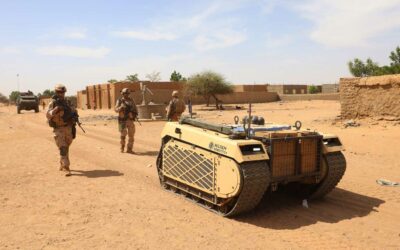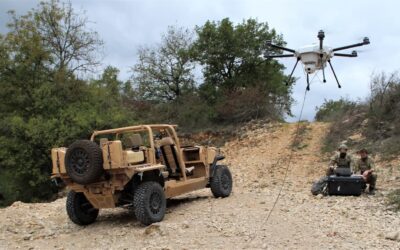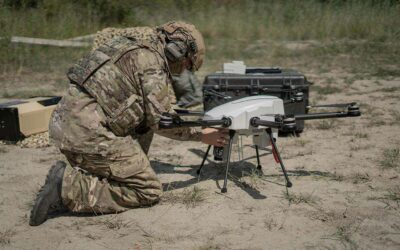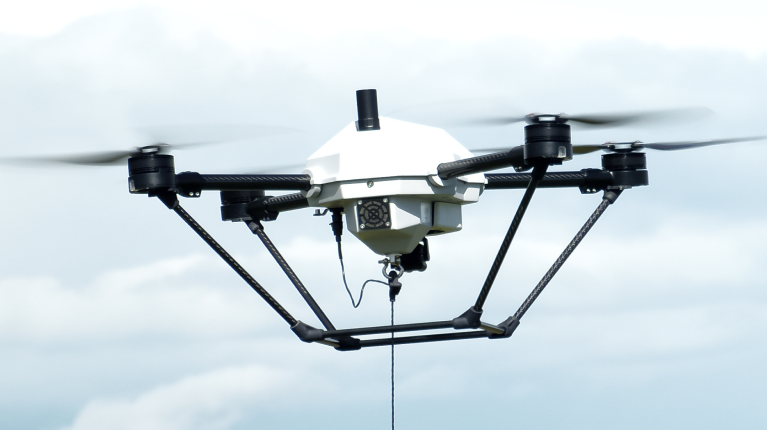Tactical communications: the role of tethered drones

David Daly
10 minutes
As tactical communications continue to advance, military forces around the world are adopting defense UAV technology. Tethered military drones offer several significant benefits, making this platform a vital tool for warfighters and first responders.
Soldiers are becoming nodes within a greater network of information collection and dissemination. Miniature drones, augmented-reality headsets, and improved communications gear are becoming part of the modern soldier’s combat load.
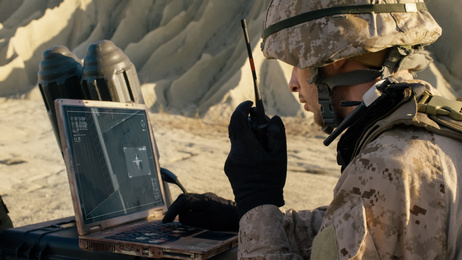
Tactical Communications: Where Tethered Drones Fit In
To make mobile networks work better, we need tools that help us use these systems effectively. A shift to decentralized decision-making is essential for this. Defense drones are a force multiplier in this space.
- These aerial platforms are excellent intelligence, surveillance and reconnaissance (ISR) collection assets.
- You can also use them to create and expand mobile networks. We achieve this without losing the warfighter’s need for mobility.
Many advantages exist for using drones for tactical communications. UAV technology is easy to set up and requires little time to do so, allowing rapid deployment. ISR aircrafts can extend the range of a mobile network while keeping soldiers safe from dangerous RF exposure.
The unlimited autonomy of tethered drones
One major drawback of using untethered drones for network coverage and ISR is their short flight time. Lithium polymer (LiPo) batteries power most untethered drones. On average, these types of batteries can sustain flight times of 20 to 30 minutes. Even the most ambitious designs can only remain in flight for an hour or so.
Combat environments require constant ISR coverage, and future combat environments will require consistent mobile networks. Even hour-long flight durations are not acceptable for this task. Tethered drones, by contrast, have near limitless power and thus can stay airborne for long periods.
Elistair’s Orion 2 drone utilizes the SAFE-T 2 tethered drone station as its ground power station. The SAFE-T 2 is a modular metallic structure, compact. You can easily integrate it into military and law enforcement vehicles.
Where traditional setups can take hours tethered systems can be ready 15 minutes. With the SAFE-T 2 base station, the Orion 2 can stay airborne for a full 50 hours, acting as a variable height antenna.
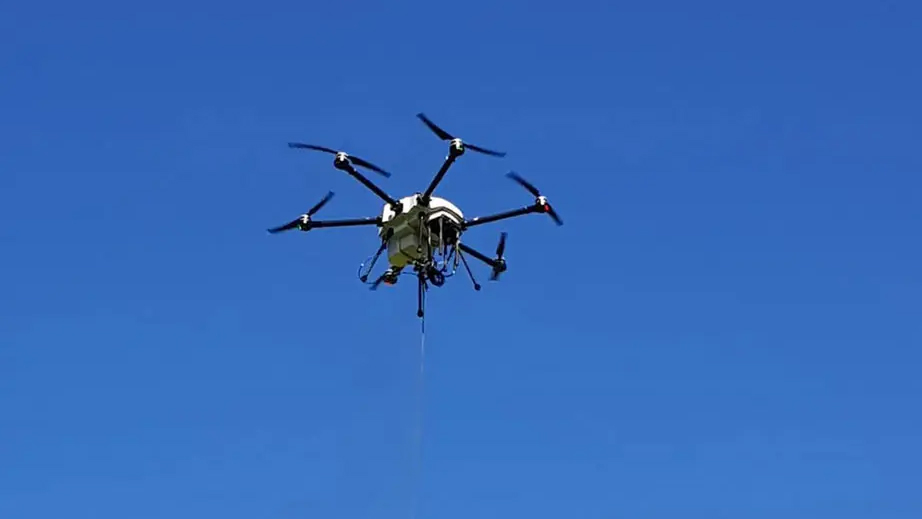
“Having the antenna at a high level by its very nature will keep the RF away from people and will reduce the possibility of people coming into areas where the RF is at a high level.”
Tethered UAVs for tactical communications require no specific training
Flying untethered drones is an acquired skill. Becoming a proficient drone pilot requires many hours of training.
To become skilled, a pilot usually needs at least 50 flight hours. However, many experts say that professional pilots should have 200-300 hours. This time should include flying in different conditions and using various types of UAVs.
Tethered drones, like Khronos, eliminate the need for hours of training and flight time. Because the platform is static, users can easily create and keep situational awareness with just a click. There is no need for advanced drone flying skills.
The Limitations of Ground-Based Equipment
For most militaries, the telecommunications world is a centralized model shifting to a decentralized network. The old model looks at warfare from the viewpoint of the commander. Engineers designed telecommunications equipment to send information up the chain of command. The model proved effective when decision-makers removed themselves from frontline combat elements.
Users often pair radios such as SINCGARS with mobile antenna units like the OE-254 to increase their effectiveness. The OE-254 is a ground-based antenna system. It takes time to set up, which makes it less suitable for units that need to move quickly.
Typically, several soldiers need to work together to erect the antenna and secure it to the ground. Rough terrain also causes issues when using systems like the OE-254. The loss of the line of sight between antennas and radio systems creates dead space.
Network ranges expand and contract as the operation develops. Having a node on a measurable medium allows us to increase our network’s range and/or decrease our network’s range simply by raising or lowering the drone.” Mark continues by stating that raising the antenna by every 5 feet adds a half-mile of range to the network. “Raising the node above trees, buildings, and vehicles will greatly enhance a high-gain antenna’s line of sight properties. Clear line of sight is vital.”
Tethered drones can expand the network node
Tethered systems are a much better option when compared to the OE-254 and systems like it. Mark A Stone, a C4/ISR Business Rep/SME at Federal Solutions, expands on this point.
The modern soldier requires collecting and acting on ISR to shoot, move, and communicate. Radios that only send and receive voice messages do not help much in this effort. In some cases, they can even make it harder for soldiers to be effective.
Additionally, legacy military communication systems lack many of the advantages seen in their commercial counterparts. They have combat advantages like modulation, encryption, and amplification. However, they usually only transmit voice using FM, AM, and MSK.
Commercial units can transmit voice, data, location, and SMS over QAM, QPSK, and DSS. The commercial units are much better equipped to handle IoT and the decentralized network model.
In a time when radios are more like network devices, FM, AM, and MSK are not enough. They cannot meet the bandwidth and data needs of today’s and future conflicts.
Communication assets that rely on satellites are also a part of modern telecommunication assets but have their own limitations. In most cases, companies own the satellites that the military uses, not the government. This forces the government to rely on outside parties to keep these systems operational. Adversaries could also target satellites and render satellite-based communications useless.
Satellite communications have a practical limitation. They enable communication beyond the line of sight.
However, electronic warfare and cyber-attacks can disrupt them. With more IoT devices on the battlefield, satellite communications do not have enough bandwidth. They struggle to handle many new nodes quickly.
The demand for bandwidth is increasing due to new telecommunications technology. Adding more satellites will be challenging to meet this demand. To be an effective fighting force, soldiers on the ground must become part of a mobile network.
Designers will need to create radios of the future as part of a software-defined network. These mobile networks and their nodes need support from assets like tethered drones. These drones will help increase their range and power while keeping mobility intact.
Mobility is key for modern warfighters
Combatants will need to be constantly on the move. Mobile networks are the best solution for supporting this type of fighting.
The United States Army thinks tactical networks will work well if they have mobile command posts. They also need secure wireless communications, strong cybersecurity, and edge computing. It is a view shared by many forces around the world.
Commanders now realize that spending hours to set up command tents uses a lot of resources. This also reduces their situational awareness. This type of setup limits the flexibility of the warfighter and makes maintaining the tempo of military operations difficult.
The important use of wireless systems
The move from tethered communications to wireless has been historically slow for militaries around the world. A change must come in the form of small encrypted wireless systems serving various roles across the battlefield.
Soldiers can transfer and receive information over WiFi, LTE, and MIMO. They can also use Mobile Network-Multiple Input Multiple Output (MN-MIMO).
MN-MIMO is particularly interesting. This advanced waveform can provide reliable, high bandwidth, mesh video and data communications even in restrictive environments such as combat theaters. MN-MIMO combines multiple antennas and digital signal processing to enhance the performance of wireless mesh networks (MANET).
The system can even be attached to drones like the Orion 2 for added expansion of the network’s range. Aerial relays, like those created with tethered drones, allow for rapid set up and continuous situational awareness. Advances like this will become the requirement for any military looking to stay competitive.
Mobile networks will need to have the ability to withstand cyber-attacks from adversary forces. The mobility of these networks will help achieve this goal. They leave a smaller digital footprint than older setups. Large, established bases have many systems that are easy targets for attacks.

